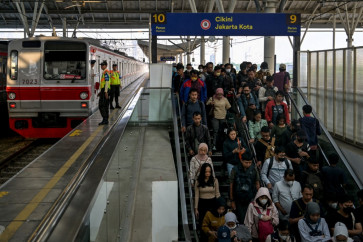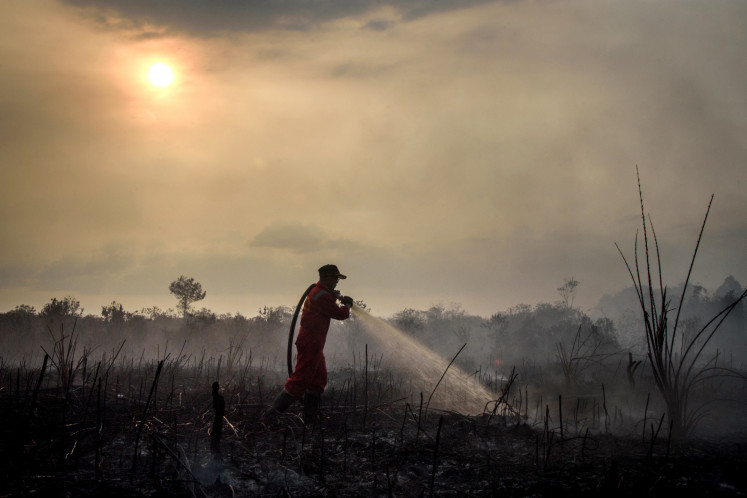Popular Reads
Top Results
Can't find what you're looking for?
View all search resultsPopular Reads
Top Results
Can't find what you're looking for?
View all search resultsBeauty standards show racism runs deep
As riots and protests against racism toward “black” university students in Surabaya raged across the country from August to September, it was difficult to ignore the fact that racism in general has had a comfortable place in Indonesian society
Change text size
Gift Premium Articles
to Anyone
A
s riots and protests against racism toward “black” university students in Surabaya raged across the country from August to September, it was difficult to ignore the fact that racism in general has had a comfortable place in Indonesian society. The issue of racism in the country is more deep-rooted than one might think.
At a recent fashion show, model and actress Kelly Tandiono opened up about being bullied for her “black” and “darker” skin, stating that it had inspired her in her journey to become a successful model. Nineteen-year-old actress Amanda Rawles has also spoken out about being verbally abused and bullied at school for her “darker” skin.
It is shocking that racism could exist among children and in schools in this day and age.
Yet the word racism wasn’t raised, either by the actresses or in the articles they were referred to in. It is as if it is commonplace, that there is nothing extraordinary about the clear racism and the incidents they touched upon.
The sad fact is that racism is still a prevailing norm. One in four Indonesian girls under 18 have said that having “white” skin is more important than being happy, a ZAP Beauty Index survey found.
In the survey of 17,000 Indonesian females, more than 70 percent of respondents believed that having “clean” bright, white skin was the definition of beauty.
Having darker skin color, or being “black” is something to be ridiculed. In Indonesian, the word “black” is derogative. On the other hand, being “white” is highly praised. Beyond beauty, being “white” also connotes wealth and status.
More than bullying in schools and verbal abuse, the perception is that lighter-skinned women get jobs easier, are better paid and so on. Hence this is why being of fairer and lighter skin color is seen as a commodity, something needed for survival and economic improvement.
It is widely assumed that these racist tendencies are a byproduct of the colonial era, which have led us to idolize the white skin color of our former European rulers. However, research has found that these tendencies date back to a time before colonial rule. In our folklore, antagonists are mostly portrayed as being darker skinned, to scare people, while lighter-skinned characters are usually the protagonists, the heroes. One example is the legend of Ramayana, in which the main character Sinta is described as beautiful as the white and bright moon, whilst villains King Dasarata and Rahwana are described as dark-skinned figures.
It is clear that this racism has been long embedded in some parts of our society. In a survey undertaken by the National Commission on Human Rights (Komnas HAM) in Indonesia just last year, it was found that more than 80 percent of those surveyed feel more comfortable, and prefer living with people of the same race. This shows that the stigma toward those of different skin color has clearly caused unease for those living in a multiracial environment, or that a multiracial environment is a potential turnoff for would-be residents.
The survey also found that a surprising 90 percent of people feel that they have never experienced racism, leading to many suspecting that there is a lack of understanding of what racism and other forms of discrimination are, causing them to not take actual racist and discriminatory behavior as serious violations. This leads to the normalization of racism, making it so ingrained in daily life without critical views. It is no surprise that both Kelly and Amanda spoke of their clear experience with racism rather lightly, as if they were being bullied for the color of their hair, or the clothes they wore.
Neither Kelly nor Amanda is black. They are both Asians of a darker skin tone. Considering their experiences as darker-skinned Asians, it is sadly no surprise at all that the black university students experienced racism the way they did.
Representation of black people in top government positions has continued to be poor. Recently, there was only one minister of Papuan background. Without someone in a position of power gaining the chance to fight for more empowerment and ways to decrease racism in Indonesian society, there will be no change. Creating a post in the Cabinet for a minister to specifically cover equality of race, ethnicity and gender would certainly lead to more action being taken.
Small steps, such as more diverse representation in media and television nationally, playing roles not conforming to stereotype, would certainly help change and oust old racist views. A quota, to make sure that black and darker-skinned Indonesians are getting more air time, such as on the much-loved soap operas, should be created. Producers of beauty products should be encouraged to use black or darker-skinned models for advertising campaigns to eliminate the stigma toward darker-skinned women.
It is difficult to find a way to move forward. The Papuan students should continue to protest to raise awareness of outward racism. However, until as a collective ideal, society realizes that your wealth, your status and your beauty is gained through your character — and not your complexion — that underlying prejudice will certainly stay strong.










